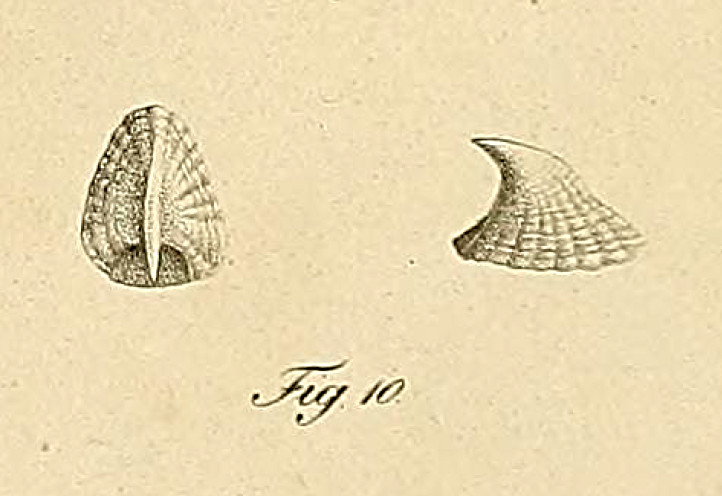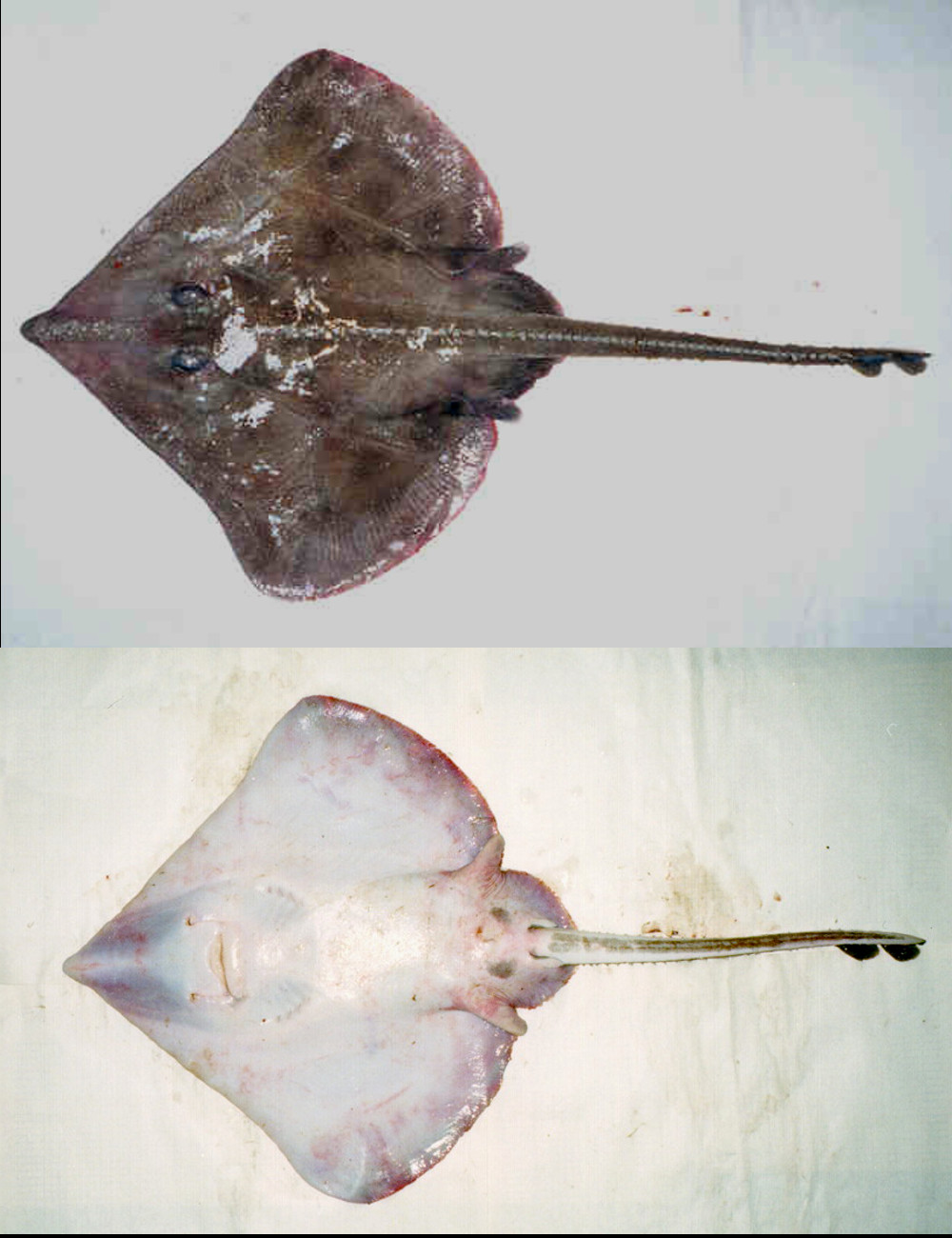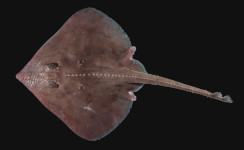Rajella lintea
(Fries, 1838)
Sailray
Classification: Elasmobranchii Rajiformes Rajidae
Reference of the original description
Granskning af de vid Svenska kusterna förekommande arter af Fisk-slägtet Raja. Kongliga Vetenskaps Akademiens nya Handlingar, Stockholm 1838: 126–164, Pls. 2–3.
Granskning af de vid Svenska kusterna förekommande arter af Fisk-slägtet Raja. Kongliga Vetenskaps Akademiens nya Handlingar, Stockholm 1838: 126–164, Pls. 2–3.
Image of the original description

Raja lintea Fries, 1838, Pl. III, fig. 10

Raja lintea Fries, 1838, Pl. III, fig. 10
Synonyms / new combinations and misspellings
Dasybatis lintea, Dipturus lintea, Dipturus linteus, Leucoraja lintea, Raia ingolfiana, Raia lintea, Raja ingolfiana, Raja lintea, Raja (Dipturus) lintea
Dasybatis lintea, Dipturus lintea, Dipturus linteus, Leucoraja lintea, Raia ingolfiana, Raia lintea, Raja ingolfiana, Raja lintea, Raja (Dipturus) lintea
Description :
Citation: Rajella lintea (Fries, 1838): In: Database of modern sharks, rays and chimaeras, www.shark-references.com, World Wide Web electronic publication, Version 12/2025
Please send your images of "Rajella lintea" to info@shark-references.com

Rajella lintea (Fries, 1838), female, TL 94 cm, TW 4855 g, 5.12.1998, Barents Sea, Nordkyn bank, 71° 48' N, 23° 26' E © Andrey Dolgov

Rajella lintea (Fries, 1838), female, TL 94 cm, TW 4855 g, 5.12.1998, Barents Sea, Nordkyn bank, 71° 48' N, 23° 26' E © Andrey Dolgov
Common names
 Weißroche,
Weißroche,  Weißrochen,
Weißrochen,  Raya vela,
Raya vela,  Raie blanche,
Raie blanche,  Raie linon,
Raie linon,  Raie voile,
Raie voile,  Linen skate,
Linen skate,  Pale ray,
Pale ray,  Sailray,
Sailray,  Sailskate,
Sailskate,  Sharp-nosed skate,
Sharp-nosed skate,  Sharpnose skate,
Sharpnose skate,  Razza blanca atlantica,
Razza blanca atlantica,  Raia-nevoeira
Raia-nevoeira
 Weißroche,
Weißroche,  Weißrochen,
Weißrochen,  Raya vela,
Raya vela,  Raie blanche,
Raie blanche,  Raie linon,
Raie linon,  Raie voile,
Raie voile,  Linen skate,
Linen skate,  Pale ray,
Pale ray,  Sailray,
Sailray,  Sailskate,
Sailskate,  Sharp-nosed skate,
Sharp-nosed skate,  Sharpnose skate,
Sharpnose skate,  Razza blanca atlantica,
Razza blanca atlantica,  Raia-nevoeira
Raia-nevoeira
Short Description
Snout moderately long, its tip pointed and somewhat protruding; upper surface predominantly smooth, only on head and front margins more or less prickly, tail entirely spinulose, underside smooth; up to 4 thorns in front of as well as behind eye, a continuous median row of 42-51 thorns from nape to first dorsal fin [7182]. Upper surface plain fawn color, slate grey or clay grey, lower surface white, with a grey longitudinal band along tail and grey blotch on either side of cloaca [199]. Diet: Barents Sea (data base: of 5 stomachs examined): In the stomachs of two young individuals of 22–28 cm TL caught on the Fugløy Bank (mean fullness indices of 28.1–62.2°/°°°) only Gammaridea were found. Food composition of larger individuals was more varied. The stomach of a 72 cm TL male (mean fullness index of 140.0°/°°°) caught at the Nordkyn Bank contained 9 northern shrimp of 2.5–11 cm TL, 4 Sabinea septemcarinata of 4–6 cm TL, 1 Munida sp. of 2.5 cm carapace length, and the remnants of Ophiura spp. The stomach of a 94 cm female (fullness index of 661.6 °/°°°) caught in the same area contained mainly fisheries waste. Additionally, it contained one northern shrimp of 10 cm TL, and one Norway pout (Trisopterus esmarkii) of 18 cm TL. [5910];
Snout moderately long, its tip pointed and somewhat protruding; upper surface predominantly smooth, only on head and front margins more or less prickly, tail entirely spinulose, underside smooth; up to 4 thorns in front of as well as behind eye, a continuous median row of 42-51 thorns from nape to first dorsal fin [7182]. Upper surface plain fawn color, slate grey or clay grey, lower surface white, with a grey longitudinal band along tail and grey blotch on either side of cloaca [199]. Diet: Barents Sea (data base: of 5 stomachs examined): In the stomachs of two young individuals of 22–28 cm TL caught on the Fugløy Bank (mean fullness indices of 28.1–62.2°/°°°) only Gammaridea were found. Food composition of larger individuals was more varied. The stomach of a 72 cm TL male (mean fullness index of 140.0°/°°°) caught at the Nordkyn Bank contained 9 northern shrimp of 2.5–11 cm TL, 4 Sabinea septemcarinata of 4–6 cm TL, 1 Munida sp. of 2.5 cm carapace length, and the remnants of Ophiura spp. The stomach of a 94 cm female (fullness index of 661.6 °/°°°) caught in the same area contained mainly fisheries waste. Additionally, it contained one northern shrimp of 10 cm TL, and one Norway pout (Trisopterus esmarkii) of 18 cm TL. [5910];
Distribution
Northeast Atlantic: Iceland and along rise to Faroes, also Norwegian coasts and Skagerrak. Northwest Atlantic: western Greenland. Source: www.gbif.org
Northeast Atlantic: Iceland and along rise to Faroes, also Norwegian coasts and Skagerrak. Northwest Atlantic: western Greenland. Source: www.gbif.org
Human uses
gamefish: yes
gamefish: yes
Biology
Oviparous [7182]. Paired eggs are laid. Embryos feed solely on yolk [733]. Distinct pairing with embrace. Young may tend to follow large objects, such as their mother [17086]. Occurs in moderately deep water but mainly around 250 m in boreal and partly arctic latitudes. Feeds on all kinds of bottom animals.
Oviparous [7182]. Paired eggs are laid. Embryos feed solely on yolk [733]. Distinct pairing with embrace. Young may tend to follow large objects, such as their mother [17086]. Occurs in moderately deep water but mainly around 250 m in boreal and partly arctic latitudes. Feeds on all kinds of bottom animals.
Size / Weight / Age
123 cm TL (male/unsexed; (Ref. 40637)); max. published weight: 11.2 kg (Ref. 40637)
123 cm TL (male/unsexed; (Ref. 40637)); max. published weight: 11.2 kg (Ref. 40637)
Remarks
shark-references Species-ID=12317;
shark-references Species-ID=12317;
Parasites (arranged by Jürgen Pollerspöck)
Monogenea
Cestoda
Trematoda
Monogenea
- Dictyocotyle coeliaca Nybelin, 1941 [17150]
Cestoda
- Grillotia erinaceus (Van Beneden, 1858) [7411]
Trematoda
- Otodistomum veliporum (Creplin, 1837) Stafford, 1904 [22616]

















